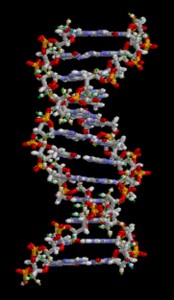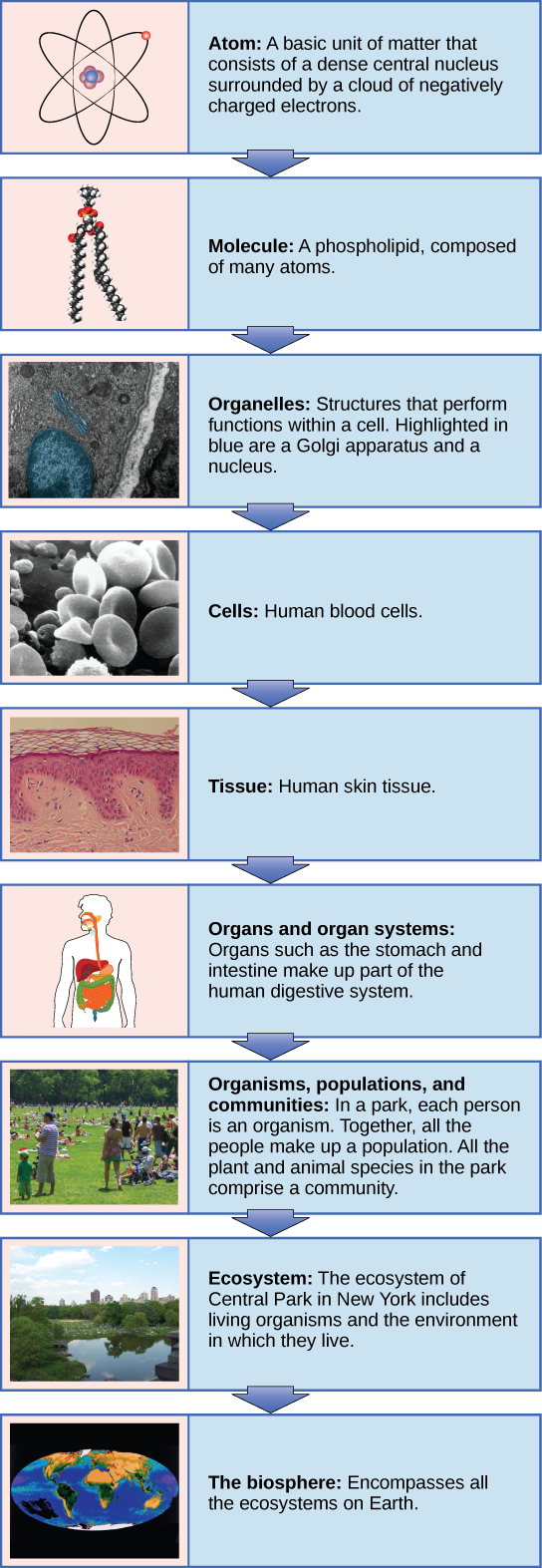2.2 Levels of Organization of Living Things
Learning Objectives
By the end of this section, you will be able to:
- Describe the levels of organization among living things
Living things are highly organized and structured, following a hierarchy on a scale from small to large. The atom is the smallest and most fundamental unit of matter. It consists of a nucleus surrounded by electrons. Atoms form molecules. A molecule is a chemical structure consisting of at least two atoms held together by a chemical bond. Many molecules that are biologically important are macromolecules, large molecules that are typically formed by combining smaller units called monomers. An example of a macromolecule is deoxyribonucleic acid (DNA), which contains the instructions for the functioning of the organism that contains it.

Concept in Action
To see an animation of this DNA molecule, click here.
Some cells contain a collection of macromolecules surrounded by membranes; these are called organelles. Organelles are small structures that exist within cells and perform specialized functions. All living things are made of cells; the cell itself is the smallest fundamental unit of structure and function in living organisms. This requirement is why viruses are not considered living: they are not made of cells. To make new viruses, they have to invade and hijack a living cell; only then can they obtain the materials they need to reproduce. Some organisms consist of a single cell and others are multicellular. Cells are classified as prokaryotic or eukaryotic.
Prokaryotes are single-celled organisms that lack organelles surrounded by a membrane and do not have nuclei surrounded by nuclear membranes; in contrast, the cells of eukaryotes do have membrane-bound organelles and nuclei. In most multicellular organisms, cells combine to make tissues, which are groups of similar cells carrying out the same function. Organs are collections of tissues grouped together based on a common function. Organs are present not only in animals but also in plants. An organ system is a higher level of organization that consists of functionally related organs. For example vertebrate animals have many organ systems, such as the circulatory system that transports blood throughout the body and to and from the lungs; it includes organs such as the heart and blood vessels. Organisms are individual living entities. For example, each tree in a forest is an organism. Single-celled prokaryotes and single-celled eukaryotes are also considered organisms and are typically referred to as microorganisms.
All the individuals of a species living within a specific area are collectively called a population. For example, a forest may include many white pine trees. All of these pine trees represent the population of white pine trees in this forest. Different populations may live in the same specific area. For example, the forest with the pine trees includes populations of flowering plants and also insects and microbial populations. A community is the set of populations inhabiting a particular area. For instance, all of the trees, flowers, insects, and other populations in a forest form the forest’s community. The forest itself is an ecosystem. An ecosystem consists of all the living things in a particular area together with the abiotic, or non-living, parts of that environment such as nitrogen in the soil or rainwater. At the highest level of organization, the biosphere is the collection of all ecosystems, and it represents the zones of life on Earth. It includes land, water, and portions of the atmosphere.

“organs”: modification of work by Mariana Ruiz Villareal, Joaquim Alves Gaspar; “organisms”: modification of work by Peter Dutton; “ecosystem”: modification of work by “gigi4791″ © CC BY (Attribution) “biosphere”: modification of work by NASA © Public Domain
Glossary
abiotic: non living thing (ex. rock)
atom: a basic unit of matter that cannot be broken down by normal chemical reactions
biosphere: a collection of all ecosystems on Earth
biotic: living thing (ex. pine tree)
community: a set of populations inhabiting a particular area
ecosystem: all living things in a particular area together with the abiotic, nonliving parts of that environment
eukaryote: an organism with cells that have nuclei and membrane-bound organelles
evolution: the process of gradual change in a population that can also lead to new species arising from older species
homeostasis: the ability of an organism to maintain constant internal conditions
macromolecule: a large molecule typically formed by the joining of smaller molecules
membrane: a thin, flexible layer of tissue that covers, lines, separates, or connects cells or parts of an organism, essentially acting as a barrier that controls what enters and exits a cell or cellular compartment
molecule: a chemical structure consisting of at least two atoms held together by a chemical bond
organ: a structure formed of tissues operating together to perform a common function
organ system: the higher level of organization that consists of functionally related organs
organelle: a small structure that exist within cells and perform specialized functions
organism: an individual living entity
population: all individuals within a species living within a specific area
prokaryote: a unicellular organism that lacks a nucleus or any other membrane-bound organelle
tissue: a group of similar cells carrying out the same function
References
Concepts of Biology – 1st Canadian Edition Copyright © 2015 by Charles Molnar and Jane Gair is licensed under a Creative Commons Attribution 4.0 International License, except where otherwise noted.© 2015 Charles Molnar and Jane Gair
Mt Hood Community College Biology 101 Copyright © 2016 by Lisa Bartee and Christine Anderson is licensed under a Creative Commons Attribution 4.0 International License, except where otherwise noted.

